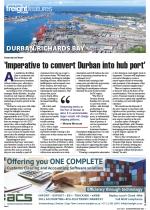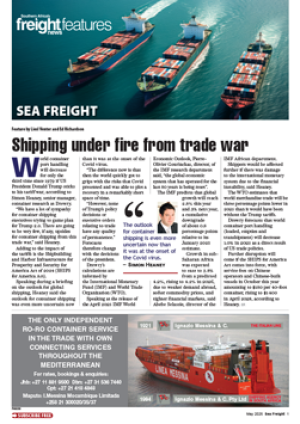The recent launch of the second trade zone at the Dube Tradeport Special Economic Zone (SEZ) adjacent to Durban’s King Shaka International Airport is a clear sign that the province is open for business. Freight NewsFeatures editor Liesl Venter spoke to Hamish Erskine, CEO Dube Tradeport SEZ, about the new developments and his outlook post-Covid.■ FN: There is a lot of excitement about the launch of Dube TradeZone 2. Tell us more about what this zone entails.■ HE: The launch of Dube TradeZone 2 is the expansion of the industrial precinct, opening an additional 38ha of developable land which is geared for high-value manufacturing. This includes electronics, and increasingly medical and pharmaceutical manufacturing, which we are pursuing as investors within the zone. At this stage, we have successfully completed the bulk earthworks and are currently completing the bulk infrastructure to service the land for the development of top structures. ■ FN: What are the benefits of TradeZ one 2?■ HE: The value proposition is its location, which affords manufacturers efficient access to local, regional and international markets – along with a secure and well-managed precinct with world-class infrastructure and support services, including various development, customs and fiscal incentives. It provides manufacturers and developers with a prime location for medical and pharmaceutical manufacturing and distribution facilities, allowing them to efficiently supply local and regional African markets. The location of the development is within an international airport precinct, 100m from the Dube Cargo Terminal (King Shaka International Airport). This is connected to over 100 international markets around the world through Qatar Airways f lights to Doha which ensure products can reach every corner of the globe in 24 hours. ■ FN: What type of footprint are you looking for in TradeZone 2?■ HE: Although the development area is 38ha within our precinct, we aim to attract investments that will grow to establish local supply chains, expanding the impact of the development throughout KwaZulu-Natal and South Africa. ■ FN: How will it be complementing the existing developments?■ HE: Over the last seven years of developing the first phase of Dube TradeZone we have had a lot of opportunities to engage and learn from the market. Through this expansion we intend to apply those lessons by delivering a product that responds to market demands. Some of the key lessons are setting aside sites for high-value manufacturing – and we are going for a clustered approach which will allow us to deliver added value to manufacturers in the form of specialised infrastructure that will make the precinct a more enabling environment for them. ■ FN: From a logistics point of view are you seeing an increase in uptake at the TradePort and is the majority interest still in manufacturing?■ HE: Within the industrial precinct, manufacturing and assembly operations are certainly the majority. We do however have a dedicated Dube Trade House, which is home to freight forwarders and consolidators. This building is connected to our Dube Cargo Terminal via a ULD automated airbridge for ease of transfer of cargo. ■ FN: Dube is one of only a few SEZs to have drawn significant investment. What is the recipe for success of the TradePort and how do you manage to bring these big investments?■ HE: Over the years Dube TradePort SEZ has enjoyed a good relationship with the private sector, which has allowed the organisation to develop a business model where private developers have an opportunity to lease serviced land from Dube TradePort and develop top structures for the private sector. This has allowed these developers the opportunity to leverage the value proposition of Dube TradePort SEZ. This has given the entire development the momentum it needs to attract further development as investors now understand the product they are investing in. It has created a good balance between public and private investment into the zone. ■ FN: What is the importance of the TradePort to Durban and to the region?■ HE: Internationally it's understood that although airfreight accounts for only 20% of volume, it represents 70% of value in the global logistics value chain.Dube TradePort SEZ’s goal is to be an economic catalyst for the region, by increasing the amount of high-value goods that are manufactured in Durban and exported. The TradePort allows space for value-added manufacturing and assembly. Thanks to its proximity to the Port of Durban, bulk goods can be imported, value added locally and the final product exported from the airport. ■ FN: What is the outlook for the Tradepor t? ■ HE: Expansion of its development zones, with Dube TradeZone 2 expected to come online in 2022 and Dube AgriZone 2 around the same time. The provincial government has also given Dube TradePort the mandate to lead the development of the Durban Aerotropolis, which is a mega development covering 32 000ha, stretching from Umhlanga in the south, to Ballito in the north, and Ndwedwe in the west. This project has a 50-year development horizon and involves several landholders including eThekwini and KwaDukuza municipalities, along with the provincial government of KwaZulu-Natal.

